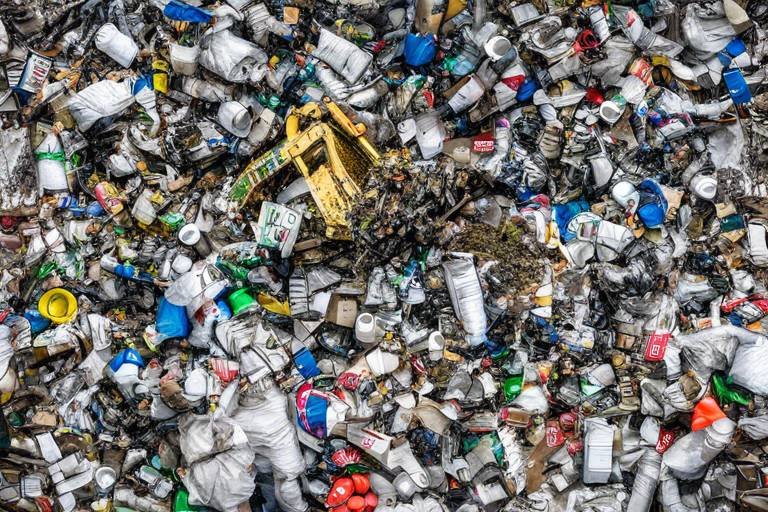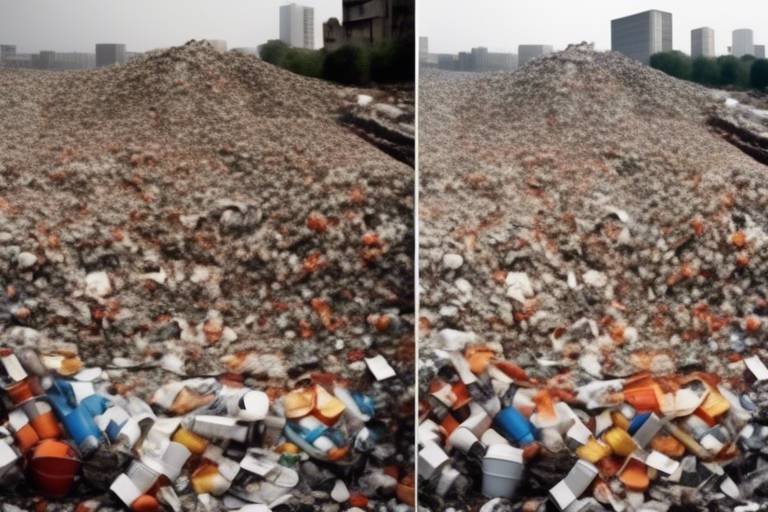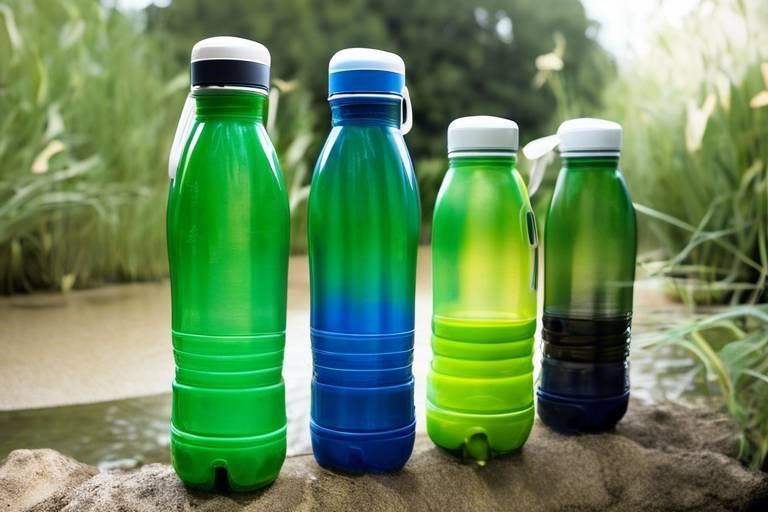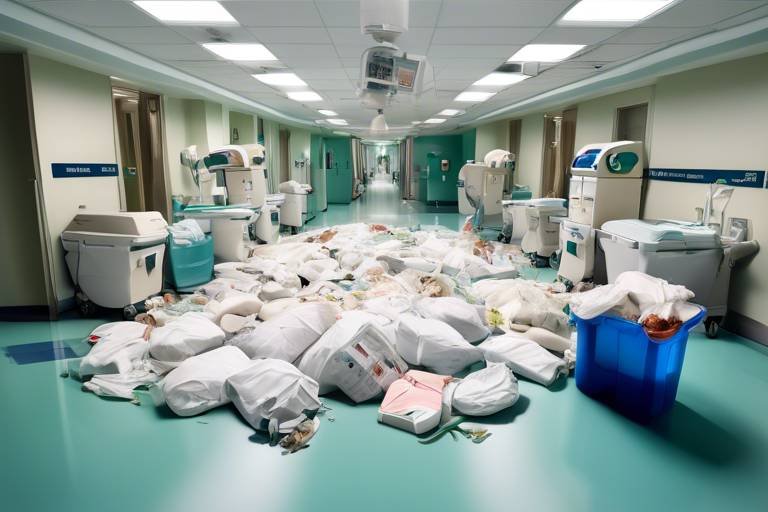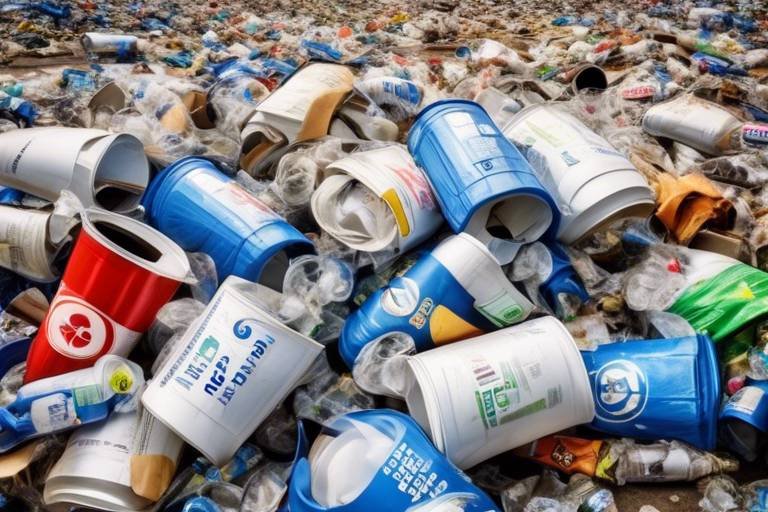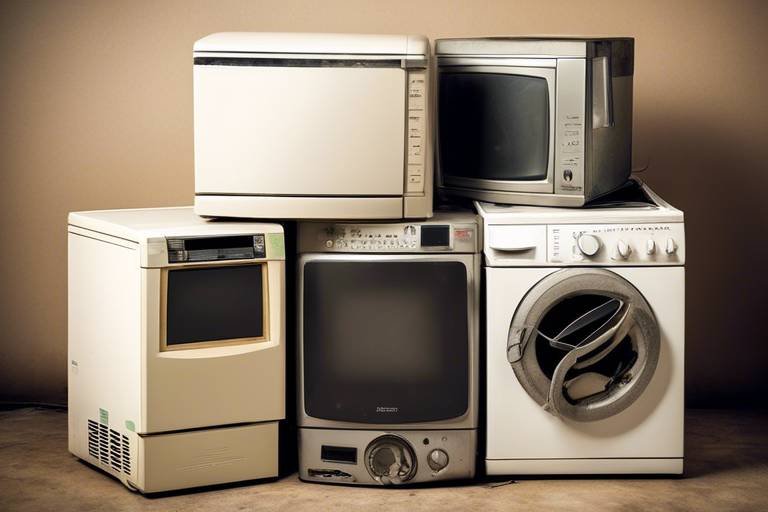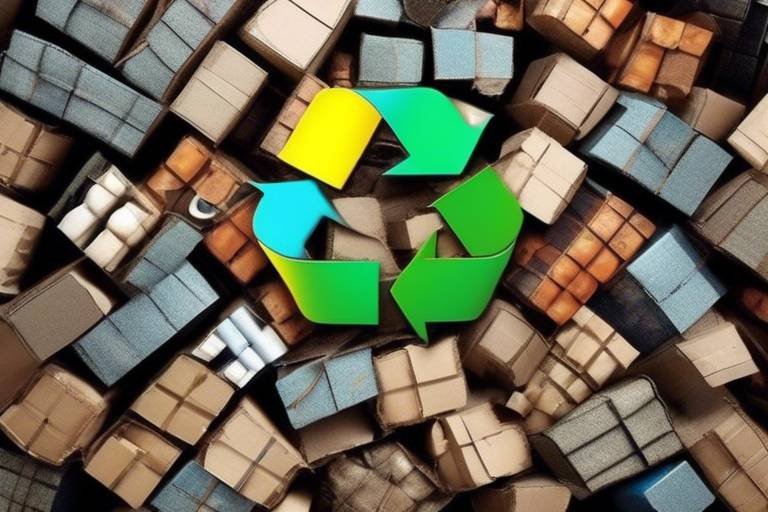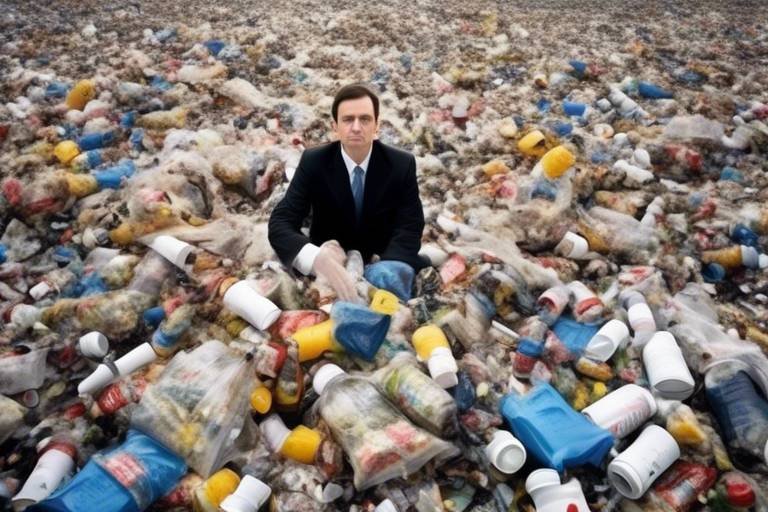How DIY Crafts Can Contribute to Waste Reduction
In a world increasingly burdened by waste, the idea of DIY crafts emerges as a beacon of hope. Not only do these creative endeavors allow individuals to express their artistic flair, but they also play a crucial role in waste reduction. Imagine turning what would otherwise end up in a landfill into something beautiful and functional. This article dives into the myriad ways DIY crafts can help minimize waste, promote sustainability, and inspire a community of eco-conscious creators.
At the heart of DIY crafting lies the concept of upcycling. This transformative process takes discarded materials and elevates them into something of greater value. Think about it: when you upcycle, you're not just reducing the amount of waste sent to landfills; you're also sparking your creativity. For instance, an old wooden pallet can become a stunning garden bench, while a worn-out pair of jeans can be turned into a stylish bag. By embracing upcycling, we not only minimize resource consumption but also significantly reduce our environmental impact.
Household waste is often seen as a nuisance, but what if we told you that many common items can be transformed into stunning crafts? The possibilities are endless! From toilet paper rolls to old magazines, everyday items can be repurposed into functional or decorative pieces. For example, you can create unique wall art using magazine cutouts or even turn cereal boxes into organizers. By thinking outside the box, you can give new life to materials that would otherwise be discarded.
Glass jars are among the most versatile items in our homes. They can be used for a plethora of DIY projects, ranging from storage solutions to stunning decor. Here are some creative ideas for reusing glass jars:
- Storage Containers: Use them to organize your pantry or craft supplies.
- Decorative Candle Holders: Transform them into charming candle holders.
- Planters: Create beautiful indoor gardens.
Transforming glass jars into candle holders can add a touch of charm to any space. You can paint them, wrap them in twine, or even etch designs onto the glass. The soft glow of a candle shining through a beautifully crafted holder creates an inviting atmosphere. The best part? It’s incredibly simple and can be customized to fit your home decor!
Glass jars also make fantastic planters or terrariums. With just a few stones, soil, and your favorite plants, you can create a miniature garden right on your windowsill. Not only does this add a splash of greenery to your home, but it also helps purify the air. Plus, it’s a great conversation starter!
Old clothing doesn’t have to end up in the trash. Instead, consider how you can repurpose those worn-out garments into something new and exciting. For instance, a faded t-shirt can be transformed into a trendy tote bag, while a pair of jeans can become a stylish cushion cover. The process of giving new life to old clothes not only reduces textile waste but also allows for a unique expression of your personal style.
Crafting workshops are more than just a fun activity; they promote community engagement and sustainability. By participating in these workshops, individuals can learn new skills and share their knowledge with others. This collaborative environment fosters creativity and encourages sustainable practices. Imagine learning how to make a beautiful piece of art while connecting with like-minded individuals who are equally passionate about reducing waste.
Crafting workshops provide a space for individuals to come together and share their love for DIY projects. This sense of community is vital in promoting sustainable practices. When people come together, they inspire one another, share ideas, and create a ripple effect of eco-conscious crafting.
Many workshops focus on teaching eco-friendly techniques that can be applied in everyday crafting. From natural dyeing methods to using recycled materials, participants can acquire valuable skills that contribute to waste reduction. Imagine walking away from a workshop not only with a new crafting project but also with the knowledge to make more sustainable choices in your crafting journey.
In today’s digital age, social media platforms serve as powerful tools for sharing DIY projects and inspiring others. By showcasing your crafting journey online, you can motivate friends and followers to engage in sustainable crafting practices. The impact of a single post can ripple through your community, encouraging others to think twice before tossing out items that could be creatively reused.
Sharing personal crafting journeys can be incredibly motivating. When you post about your successes—whether it’s a beautifully upcycled piece of furniture or a unique gift made from recycled materials—others are likely to be inspired to try their hand at DIY crafting. Success stories create a sense of possibility and encourage a wider audience to adopt eco-friendly practices.
Online platforms allow crafters to connect and collaborate, fostering a sense of belonging among eco-conscious creators. Whether through Facebook groups, Instagram hashtags, or dedicated crafting forums, these digital spaces enable individuals to share ideas, techniques, and inspiration. By engaging in these communities, crafters can further promote sustainability and waste reduction.
Q: What materials can I use for upcycling?
A: Almost anything can be upcycled! Look for old clothes, glass jars, cardboard, and even furniture.
Q: How do I start my DIY crafting journey?
A: Begin with simple projects that interest you. There are countless tutorials online to guide you!
Q: Can crafting really make a difference in waste reduction?
A: Absolutely! By repurposing materials, you help reduce landfill waste and promote sustainability.
Q: Where can I find local crafting workshops?
A: Check community centers, local craft stores, or online platforms like Meetup to find workshops near you!

The Importance of Upcycling
Upcycling is not just a trendy buzzword; it’s a vital practice that allows us to breathe new life into materials that would otherwise end up in landfills. Imagine transforming a worn-out item into something functional and beautiful. It’s like giving trash a second chance at life! By engaging in upcycling, we not only unleash our creativity but also significantly reduce our environmental footprint. The process of upcycling involves taking materials that are considered waste and turning them into products of greater value. This means we are minimizing the consumption of new resources while maximizing the use of what we already have.
In a world where consumerism reigns supreme, upcycling serves as a powerful antidote. It challenges the notion that we need to constantly buy new items to fulfill our needs. Instead, it encourages us to look around our homes and see potential in what we might consider useless. For instance, old furniture can be sanded down and painted to create a stunning centerpiece for your living room. Similarly, discarded pallets can be transformed into rustic garden furniture, offering both charm and functionality.
But the benefits of upcycling extend beyond just personal creativity. It plays a crucial role in reducing landfill waste. According to the Environmental Protection Agency (EPA), approximately 292.4 million tons of trash were generated in the United States in 2018 alone. A significant portion of this waste could have been upcycled or recycled. By choosing to upcycle, we can directly contribute to waste reduction efforts and encourage others to do the same.
Moreover, upcycling promotes a culture of sustainability. It inspires individuals to think critically about their consumption habits and encourages a shift towards more eco-friendly practices. When we embrace upcycling, we are not only reducing waste but also spreading awareness about the importance of sustainability. This ripple effect can lead to a community of like-minded individuals committed to making a difference.
To further illustrate the importance of upcycling, let's take a look at some of the environmental impacts:
| Impact | Description |
|---|---|
| Reduces Waste | Decreases the amount of materials sent to landfills. |
| Conserves Resources | Lessens the need for new materials, saving energy and raw materials. |
| Encourages Creativity | Promotes innovative thinking and resourcefulness. |
| Builds Community | Fosters connections among individuals who share a passion for sustainability. |
In conclusion, upcycling is an essential practice that not only benefits the environment but also enriches our lives through creativity and community engagement. So, the next time you’re about to toss something in the trash, take a moment to consider how you might transform it into something extraordinary. After all, one person’s trash can truly become another person’s treasure!

Creative Uses for Household Waste
When it comes to crafting, the possibilities are virtually endless, especially when you look around your home and see potential in the items you might typically toss in the trash. Embracing a mindset of creativity and sustainability can lead to some truly innovative projects. From kitchen scraps to old newspapers, household waste can be transformed into stunning and functional pieces that not only reduce waste but also add a personal touch to your living space.
One of the most exciting aspects of using household waste in your crafts is that it encourages you to think outside the box. For instance, have you ever considered turning your empty cereal boxes into stylish storage solutions? By simply covering them with decorative paper or fabric, you can create beautiful organizers for your desk or craft supplies. This not only gives those boxes a second life but also helps keep your space tidy and organized.
Another fantastic way to repurpose household waste is by utilizing plastic bottles. Instead of discarding them, why not transform them into planters? With just a few cuts and some paint, you can create eye-catching vertical gardens or hanging planters that breathe new life into your home while nurturing your favorite plants. It's a fun way to bring a bit of nature indoors, and it encourages you to care for your environment.
Here are some more creative ideas for turning your household waste into art:
- Old T-Shirts: These can be cut into strips and braided to make colorful rugs or used to create tote bags. It's a great way to reduce textile waste!
- Egg Cartons: Instead of throwing them away, use them to create unique seed starters for your garden. Simply fill each cup with soil and seeds, and you've got a mini greenhouse!
- Toilet Paper Rolls: These can be transformed into fun crafts like bird feeders or decorative napkin rings. The only limit is your imagination!
By engaging in these creative projects, not only do you reduce waste, but you also cultivate a sense of accomplishment and joy. Plus, it can be a fun activity to do with friends or family, making it a perfect bonding experience. Imagine sitting around the table, laughing and crafting together, while also making a positive impact on the planet!
As you dive into the world of DIY crafts, remember that every little effort counts. The more you incorporate waste materials into your projects, the more you inspire those around you to do the same. It's a ripple effect that can lead to a more sustainable lifestyle for everyone. So, grab those old items lying around your house and let your creativity flow!
Q: What are some easy DIY projects for beginners?
A: Beginners can start with simple projects like making decorative jars, creating wall art from old magazines, or turning used containers into planters. The key is to choose projects that match your skill level and gradually challenge yourself.
Q: How can I ensure my DIY projects are eco-friendly?
A: To keep your projects eco-friendly, use materials you already have at home, choose non-toxic paints and adhesives, and try to minimize waste during the crafting process.
Q: Where can I find inspiration for more DIY projects?
A: Inspiration can be found on various platforms like Pinterest, Instagram, or crafting blogs. Joining online crafting communities can also provide you with fresh ideas and support.

Repurposing Glass Jars
Glass jars are not just containers; they are a canvas for your creativity! With a little imagination, these ordinary items can be transformed into extraordinary pieces that serve both functional and decorative purposes. Think about it: every time you finish a jar of jam or pickles, you’re left with a vessel that has so much potential. Instead of tossing it in the recycling bin, why not give it a new life? You can create anything from chic home decor to practical storage solutions, all while contributing to waste reduction.
One of the most exciting aspects of repurposing glass jars is their versatility. Here are some innovative ideas:
- Storage Solutions: Use glass jars to organize your pantry, craft supplies, or even small items around the house. Label them for an added touch of charm!
- Decorative Vases: Fill jars with fresh or dried flowers to create beautiful centerpieces. You can even paint or decorate the jars to match your home’s aesthetic.
- Gift Containers: Fill a jar with homemade goodies, bath salts, or candles. This makes for a personal and eco-friendly gift!
Now, let’s dive deeper into two specific projects that showcase the potential of glass jars:
Transforming glass jars into candle holders is a fun and easy project that can add a cozy ambiance to any space. Simply clean the jar, remove any labels, and get creative! You can wrap twine around the neck, paint the glass, or even use washi tape for a pop of color. Place a tea light or votive candle inside, and voilà! You have a stunning centerpiece or a charming addition to your outdoor gatherings.
Glass jars can also serve as unique planters or terrariums, bringing a touch of nature indoors. Start by adding a layer of small stones for drainage, followed by activated charcoal to keep the environment fresh. Next, add potting soil and your chosen plants—succulents work wonderfully in jars! Seal the jar or leave it open, depending on the plants' needs. You’ll not only beautify your space but also create a mini ecosystem that’s easy to care for.
In conclusion, repurposing glass jars is not just a creative outlet; it’s a way to contribute to a more sustainable future. By thinking outside the box and embracing the potential of everyday items, you can significantly reduce waste while enjoying the process of crafting. So, the next time you empty a jar, remember: it’s not just trash—it’s a treasure waiting to be transformed!
Q: What types of glass jars can I repurpose?
A: You can repurpose any type of glass jar, including mason jars, jam jars, and even old candle jars. Just ensure they are clean and free of any residue.
Q: How can I remove labels from glass jars?
A: Soaking the jars in warm, soapy water usually helps to loosen the labels. For stubborn residue, you can use a mix of baking soda and oil to scrub it off.
Q: Are there any safety tips I should consider when using glass jars for candles?
A: Yes! Always ensure that the jar is heat-resistant and never leave burning candles unattended. Placing the jar on a heat-resistant surface is also a good practice.

Decorative Candle Holders
Transforming glass jars into is not just a fun DIY project; it's a fantastic way to add a personal touch to your home while contributing to waste reduction. Imagine the warm glow of candles illuminating your space, all while knowing that you’ve crafted something unique from what would otherwise be discarded. The beauty of this project lies in its simplicity and versatility. With just a few materials and a sprinkle of creativity, you can turn ordinary jars into stunning centerpieces that catch the eye.
To get started, gather some glass jars of varying sizes. You can use anything from old jam jars to larger pickle jars. Once you have your jars, consider the following techniques to elevate their aesthetic:
- Painted Designs: Use glass paint or spray paint to add a splash of color to your jars. You can create patterns or even write inspirational quotes that will shine through when the candle is lit.
- Wrap with Twine: For a rustic look, wrap twine or jute around the neck of the jar. This adds texture and a natural feel, perfect for outdoor gatherings or cozy indoor spaces.
- Embellishments: Get crafty with embellishments! Add beads, buttons, or even dried flowers to the exterior for a personalized touch that reflects your style.
Once your jars are decorated, it’s time to place candles inside. You can use tealights for a subtle glow or pillar candles for a more dramatic effect. If you're feeling adventurous, consider using scented candles to infuse your space with delightful aromas. Not only do these candle holders beautify your surroundings, but they also serve as a reminder of your commitment to sustainability. Each time you light a candle, you're celebrating creativity and resourcefulness.
Moreover, these decorative candle holders make excellent gifts! Imagine gifting a beautifully decorated jar filled with a candle to a friend or family member. It’s a thoughtful, personalized gift that showcases your crafting skills while promoting eco-friendly practices. You can even host a candle holder-making party with friends, turning it into a fun social gathering that inspires everyone to embrace their creative sides.
In conclusion, creating decorative candle holders from glass jars is not just about beautifying your home; it’s a statement about sustainability and creativity. By repurposing materials that would otherwise end up in the landfill, you’re making a positive impact on the environment. So gather your jars, unleash your creativity, and illuminate your space with your unique creations!
Q: What types of glass jars can I use for candle holders?
A: You can use any glass jars, such as old jam jars, pickle jars, or even wine bottles. Just ensure they are clean and free of labels.
Q: Can I use real candles in the glass jars?
A: Yes, you can use real candles, but always ensure that the jar is heat-resistant and that you monitor the candle while it’s lit. Alternatively, you can use LED candles for safety.
Q: How do I remove labels from glass jars?
A: Soak the jars in warm, soapy water for a few hours, and the labels should peel off easily. You can also use rubbing alcohol or vinegar for any leftover adhesive.

Planters and Terrariums
Transforming glass jars into planters and terrariums is not just a fun DIY project; it’s a fantastic way to breathe new life into items that would otherwise end up in the trash. Imagine a world where your discarded jars sprout greenery and bring a touch of nature into your home! Not only do these projects beautify your space, but they also contribute to a sustainable lifestyle by reducing waste. Plus, they’re incredibly easy to make and can be customized to fit any decor style.
To start, gather your materials. You’ll need:
- Clean glass jars (any size will do!)
- Small rocks or pebbles for drainage
- Activated charcoal to keep the soil fresh
- Potting soil
- Your choice of plants (succulents and air plants work wonderfully!)
Once you have your supplies, the process is straightforward. Begin by adding a layer of small rocks at the bottom of the jar. This layer helps with drainage, preventing water from accumulating and potentially rotting your plants' roots. Next, sprinkle a thin layer of activated charcoal over the rocks. This step is crucial for maintaining air quality and preventing odors in your terrarium.
Now, it’s time to add the potting soil. Fill the jar with enough soil to accommodate the roots of your chosen plants. Make a small hole in the soil and gently place your plants inside, covering their roots with soil. You can create a lovely arrangement by mixing different types of plants or sticking to a single variety for a more minimalist look. Once planted, give them a light watering, and voilà! You have a stunning planter or terrarium that not only looks beautiful but also contributes to the environment.
Terrariums, in particular, can be a miniature ecosystem. They thrive on their own, creating a self-sustaining environment. Just make sure to place your terrarium in a spot with indirect sunlight and keep an eye on the moisture levels. If you notice condensation building up inside, it might be a sign that it’s too humid, and you may need to open the jar for a bit to let it breathe.
Incorporating planters and terrariums into your home decor not only enhances the aesthetic appeal but also serves as a conversation starter. Imagine guests admiring your unique creations and asking how you made them. You’ll not only be showcasing your crafting skills but also spreading awareness about sustainability and waste reduction. Each jar tells a story of transformation, reminding us that with a little creativity, we can turn waste into something beautiful.
So, why not dive into this exciting DIY adventure? It’s a rewarding way to express your creativity while doing your part for the planet. Plus, it’s a project you can enjoy alone or with friends and family, making it a perfect weekend activity!
- Can I use any type of glass jar? Absolutely! Any clean glass jar will work, whether it's a mason jar, a pickle jar, or a candle holder.
- What plants are best for terrariums? Succulents, ferns, and air plants are great choices as they thrive in a contained environment.
- How often should I water my terrarium? It depends on the plants and the environment, but generally, once every few weeks is sufficient. Just be careful not to overwater!
- Can I use artificial plants instead? Yes, artificial plants can be a low-maintenance alternative, especially if you don’t have a green thumb.

Turning Old Clothes into New Items
Old clothes often end up in landfills, contributing to the ever-growing problem of textile waste. However, with a little creativity and effort, you can transform these worn-out garments into stunning new items that serve a purpose. Imagine turning that faded t-shirt or those jeans with a torn hem into something fresh and functional! Not only does this practice promote sustainability, but it also allows you to express your personal style in unique ways.
One of the simplest yet most rewarding projects is creating reusable shopping bags from old t-shirts. With just a few cuts and stitches, you can repurpose a shirt into a fashionable tote that not only looks great but also reduces your reliance on single-use plastic bags. This is a fantastic way to make a statement about sustainability while showcasing your crafting skills.
Another exciting project is transforming old jeans into denim quilts. Not only does this project breathe new life into your favorite pairs of jeans, but it also creates a cozy and durable blanket perfect for chilly evenings. The process involves cutting the jeans into squares, sewing them together, and adding a soft backing fabric. The result? A one-of-a-kind quilt that tells a story with every patch!
Furthermore, old clothes can be turned into fashion accessories, such as headbands, scarves, or even jewelry. For instance, you can cut strips from a colorful shirt and braid them into a stylish headband that adds flair to any outfit. Alternatively, you can use fabric scraps to create unique earrings or necklaces that will surely catch the eye. The possibilities are endless, and the only limit is your imagination!
To inspire your creativity, here’s a quick table showcasing some popular DIY projects using old clothes:
| Old Clothing Item | New Item | Skill Level |
|---|---|---|
| T-shirt | Reusable Shopping Bag | Easy |
| Jeans | Denim Quilt | Intermediate |
| Shirt | Headband | Easy |
| Dress | Skirt | Intermediate |
In addition to these projects, consider hosting a clothing swap with friends or family. This not only allows you to refresh your wardrobe without spending a dime but also fosters a sense of community among those who share your passion for sustainability. Plus, it's a fun way to encourage others to think twice before tossing out their old clothes!
Ultimately, turning old clothes into new items is more than just a creative outlet; it's a powerful statement about our responsibility to the planet. By embracing DIY projects, we can significantly reduce textile waste while enjoying the satisfaction of creating something beautiful and functional. So the next time you’re about to toss that old shirt, think twice! You might just have the makings of your next favorite project.

Benefits of Participating in Crafting Workshops
Crafting workshops are more than just a place to learn how to create beautiful projects; they are vibrant hubs of community engagement and sustainability. When you step into a crafting workshop, you’re not just picking up a new hobby; you’re diving into a world where creativity meets resourcefulness. Imagine a space filled with laughter, shared ideas, and the smell of fresh paint—this is where friendships blossom and skills flourish. But what exactly are the benefits of participating in these workshops? Let's explore!
First and foremost, crafting workshops are a fantastic way to meet like-minded individuals. In these settings, you’re surrounded by people who share your passion for creativity and sustainability. This not only fosters a sense of belonging but also encourages collaboration and the exchange of ideas. Think about it: when you’re working alongside someone who is equally passionate about upcycling and DIY projects, you’re bound to learn new techniques and discover innovative approaches to crafting. These interactions can lead to lasting friendships and even partnerships in future projects!
Moreover, workshops often focus on teaching sustainable techniques. Participants get the chance to learn from skilled instructors who emphasize eco-friendly practices. Imagine learning how to turn discarded materials into stunning home decor or fashion items! By mastering these techniques, you are not only enhancing your crafting skills but also contributing to waste reduction. The knowledge gained in these workshops can be applied to your personal projects, allowing you to make more informed choices about materials and methods.
Another significant benefit is the opportunity to boost your creativity. Workshops often provide a variety of materials and tools that you might not have at home, sparking new ideas and inspirations. You might walk in with a simple vision but leave with a plethora of creative possibilities. This environment encourages experimentation; you can try out different techniques without the fear of making mistakes. After all, crafting is all about the journey, not just the final product!
Additionally, participating in crafting workshops can have a positive impact on your mental health. Engaging in creative activities has been shown to reduce stress and anxiety. When you immerse yourself in crafting, you enter a state of flow, where time seems to slip away, and worries fade into the background. This therapeutic aspect of crafting is something that many attendees cherish, making workshops not just a learning experience but a form of self-care.
In summary, the benefits of participating in crafting workshops are manifold. They provide a platform for community building, skill enhancement, and creative expression. Whether you're a seasoned crafter or a curious beginner, these workshops offer something for everyone, making them an invaluable part of the DIY culture. So, why not take the plunge? Join a local workshop, and who knows? You might just discover a new passion while making friends along the way!

Building a Community of Crafters
As we dive into the world of DIY crafts, one of the most rewarding aspects is the opportunity to build a vibrant community of crafters. Imagine a space filled with creativity, laughter, and shared experiences, where everyone is eager to learn and teach. This community isn't just about making things; it's about fostering connections and supporting one another in our crafting journeys. In a society that often feels disconnected, crafting can be the glue that binds us together.
Participating in local crafting workshops or online forums can be a game changer. These gatherings provide a platform for individuals to come together, share ideas, and collaborate on projects. They create an environment where seasoned crafters can impart their knowledge to beginners, ensuring that valuable skills are passed down through generations. This exchange of skills not only enhances our crafting abilities but also strengthens the sense of community.
Moreover, being part of a crafting community encourages sustainability. When individuals come together with a shared goal of reducing waste through creativity, the impact can be significant. For instance, group projects can focus on upcycling materials that might otherwise end up in landfills. By pooling resources and ideas, crafters can transform discarded items into beautiful creations, all while spreading awareness about the importance of sustainability.
In addition, community crafting events can take many forms, such as:
- Workshops: Hands-on sessions where participants learn new techniques.
- Craft Fairs: Opportunities to showcase and sell handmade items, fostering local economies.
- Online Challenges: Friendly competitions that encourage creativity and innovation.
Ultimately, building a community of crafters is about creating a supportive network where everyone feels valued and inspired. It's about sharing the joy of crafting, celebrating each other's successes, and learning from our failures. So, whether you're a seasoned pro or just starting out, remember that your journey can inspire others. Together, we can craft a more sustainable future, one project at a time.
Q: How can I find local crafting communities?
A: You can start by checking local community centers, libraries, or craft stores for workshops and events. Online platforms like Meetup or Facebook groups are also great places to connect with fellow crafters.
Q: What materials should I bring to a crafting workshop?
A: It often depends on the type of workshop. Generally, bringing basic supplies like scissors, glue, and any specific materials mentioned in the event description is a good idea. Don’t forget to bring your creativity!
Q: Can I participate in crafting workshops if I'm a beginner?
A: Absolutely! Many workshops cater to all skill levels, and they are a fantastic way to learn and improve your crafting skills in a supportive environment.
Q: How can I contribute to my crafting community?
A: You can contribute by sharing your skills, volunteering to organize events, or simply being an enthusiastic participant. Your passion for crafting can inspire others!

Learning Sustainable Techniques
Participating in crafting workshops is not just about creating beautiful items; it’s also an incredible opportunity to learn sustainable techniques that can significantly contribute to waste reduction. Imagine walking into a workshop filled with vibrant energy, where each participant is eager to share their knowledge and skills. You’re not just learning to craft; you’re absorbing a lifestyle that values creativity and environmental responsibility.
One of the most exciting aspects of these workshops is the chance to discover methods for using eco-friendly materials. Many instructors emphasize the importance of sourcing materials that are either recycled or sustainable. For instance, you might learn how to use leftover fabric scraps to create stunning quilts or how to transform old newspapers into beautiful paper mâché art. This not only reduces waste but also opens up a world of creativity that you may not have explored before.
Furthermore, workshops often delve into techniques that promote resource efficiency. You might find yourself learning how to properly utilize every inch of a material, minimizing waste. Consider the process of making candles from leftover wax; it’s a simple yet effective way to repurpose what would otherwise be discarded. By mastering these techniques, you can turn what seems like trash into treasure, all while reducing your ecological footprint.
In addition to hands-on crafting skills, workshops also foster discussions around sustainability. Participants often share their own experiences and tips, creating a rich tapestry of knowledge. For example, one might discuss the benefits of using natural dyes from plants instead of synthetic ones, while another shares their success in creating biodegradable glitter from natural sources. This exchange of ideas not only enhances your crafting abilities but also deepens your understanding of sustainable practices.
To help you visualize the impact of these sustainable techniques, let’s consider a few common practices learned in workshops:
| Technique | Description | Environmental Benefit |
|---|---|---|
| Upcycling | Transforming old items into new creations. | Reduces landfill waste and encourages creativity. |
| Natural Dyes | Using plants to dye fabrics instead of chemicals. | Minimizes pollution and promotes biodiversity. |
| Zero-Waste Patterns | Designing crafts that use every scrap of material. | Maximizes resource use and reduces waste. |
By engaging in these workshops, you’re not just learning to craft; you’re becoming part of a movement that values sustainability and creativity. The skills you acquire can be applied in your daily life, allowing you to make informed choices that benefit the planet. Plus, the friendships and connections you build with fellow crafters can inspire you to continue exploring sustainable practices long after the workshop ends.
So, the next time you consider joining a crafting workshop, think beyond just the project at hand. Embrace the opportunity to learn sustainable techniques that can transform not only your crafting but also your lifestyle. Together, we can create a vibrant community of eco-conscious crafters who are dedicated to making a difference, one project at a time.
- What materials can I use for sustainable crafting? You can use recycled paper, fabric scraps, natural dyes, and other eco-friendly materials.
- How can I find local crafting workshops? Check community centers, craft stores, or online platforms for upcoming workshops in your area.
- Are sustainable crafting techniques expensive? Many sustainable techniques focus on repurposing materials you already have, making them cost-effective.

Inspiring Others Through Social Media
In today's digital age, social media has become a powerful platform for sharing ideas, connecting with like-minded individuals, and inspiring change. When it comes to DIY crafts and waste reduction, social media plays a pivotal role in spreading awareness and encouraging sustainable practices. Imagine scrolling through your feed and stumbling upon a stunning upcycled project that not only catches your eye but also sparks your creativity. This is the magic of social media—it allows us to share our crafting journeys and inspire others to join the movement towards a more eco-friendly lifestyle.
Platforms like Instagram, Pinterest, and Facebook are buzzing with vibrant communities of crafters who are eager to showcase their innovative projects. By sharing photos, tutorials, and tips, these individuals create a ripple effect, motivating others to think outside the box and consider how they can repurpose their own waste materials. It's like a digital crafting circle where creativity knows no bounds!
One of the most impactful ways to inspire others is through success stories. When someone shares their personal journey—from transforming a pile of old clothes into a stylish tote bag to creating beautiful home decor from discarded items—it resonates with others. These stories not only highlight the potential of upcycling but also demonstrate that anyone can make a difference, no matter their skill level. By showcasing these projects, we can ignite a passion for crafting and sustainability in others, encouraging them to embark on their own DIY adventures.
Additionally, social media allows for the creation of online communities that foster collaboration and support. Crafters from all over the world can connect, share ideas, and provide feedback on each other's projects. This sense of belonging is crucial in promoting sustainable practices, as it encourages individuals to learn from one another and adopt eco-friendly techniques. Imagine being part of a community where everyone is working towards a common goal—reducing waste and creating beautiful, functional items from what would otherwise be discarded. It's not just about crafting; it's about building a movement!
Moreover, social media platforms often feature hashtags related to sustainability and DIY crafts, making it easier for users to discover new ideas and connect with others who share their interests. Hashtags like #Upcycling, #SustainableCrafts, and #DIYProjects can lead to a treasure trove of inspiration, showcasing everything from simple crafts to intricate designs. By participating in these conversations, we can amplify our reach and encourage even more people to consider the environmental impact of their crafting choices.
In conclusion, social media serves as an incredible tool for inspiring others to engage in sustainable crafting practices. By sharing our successes, creating supportive communities, and utilizing trending hashtags, we can motivate individuals to rethink waste and embrace the beauty of DIY crafts. So, the next time you complete a project, don’t hesitate to share it online; you never know who you might inspire to start their own journey towards waste reduction!
| Question | Answer |
|---|---|
| How can I start sharing my DIY projects on social media? | Begin by taking high-quality photos of your projects and writing engaging captions that explain your process. Use relevant hashtags to increase visibility. |
| What are some popular platforms for DIY crafting? | Instagram, Pinterest, and Facebook are great platforms for sharing DIY crafts and connecting with other crafters. |
| Can social media really make a difference in waste reduction? | Absolutely! By sharing ideas and inspiring others, social media can create a community focused on sustainability and waste reduction. |

Sharing Success Stories
In the world of DIY crafts, sharing success stories is like lighting a spark in a dark room; it not only illuminates the path for others but also fuels their motivation to embark on their own creative journeys. When individuals showcase their crafting triumphs, they inspire others to think outside the box and consider how they, too, can contribute to waste reduction through innovative projects. The beauty of these stories lies in their diversity—each crafted item tells a tale of transformation, creativity, and sustainability.
For instance, consider the story of Sarah, who turned her collection of mismatched socks into a vibrant patchwork quilt. What started as a pile of forgotten fabric became a cozy masterpiece that not only keeps her warm but also serves as a conversation starter in her living room. Sharing such stories on social media platforms can ignite a wave of creativity among followers, encouraging them to look at their own waste materials in a new light.
Moreover, success stories often include before-and-after photos, which are incredibly powerful. They visually demonstrate the potential of what might otherwise be discarded. When people see the transformation from trash to treasure, it encourages them to envision their own possibilities. For example, a simple glass jar can be transformed into a stunning lamp or a decorative vase, and seeing someone else's journey can be the nudge someone needs to try it themselves.
In addition to personal stories, community success tales can amplify the impact. Local crafting groups or workshops often share collective achievements, highlighting the power of collaboration. When individuals come together to share ideas and resources, the results can be astonishing. Imagine a neighborhood project where old furniture is refurbished and given new life, creating not just beautiful pieces but also strengthening community bonds.
Furthermore, sharing these stories doesn't just motivate individuals; it creates a ripple effect. As more people engage in sustainable crafting, the message spreads that creativity and environmental consciousness can go hand in hand. It fosters a culture of sustainability where everyone feels empowered to make a difference, no matter how small. This is especially important in today's world, where environmental challenges are at the forefront of societal concerns.
Ultimately, sharing success stories in the DIY crafting community is about more than just showcasing finished products; it’s about building a movement. It’s about celebrating creativity, inspiring others to take action, and reminding everyone that waste reduction can be both fun and fulfilling. So, the next time you complete a project, consider sharing your journey. You never know who you might inspire!
- What types of materials can I use for DIY crafts? Almost anything! Common materials include glass jars, old clothing, cardboard, and even plastic bottles.
- How can I share my success stories? Use social media platforms like Instagram or Facebook to post before-and-after photos, tutorials, and tips.
- Are there specific workshops for sustainable crafting? Yes, many local community centers and online platforms offer workshops focused on eco-friendly techniques.
- Can I sell my DIY crafts? Absolutely! Many crafters sell their creations on platforms like Etsy, helping to promote sustainability while making a profit.

Creating Online Communities
In today's digital age, the ability to connect with others who share similar interests has never been easier. around DIY crafts not only fosters a sense of belonging but also amplifies the impact of sustainable practices. Imagine a vibrant space where crafters from all walks of life come together, sharing ideas, tips, and inspiration. This is the beauty of online crafting communities!
Platforms like Facebook, Instagram, and Pinterest serve as fantastic hubs for crafters to showcase their projects and share their journeys. These platforms allow individuals to post photos of their creations, exchange feedback, and even collaborate on projects. The thrill of seeing someone transform a simple piece of waste into a stunning work of art can ignite creativity in others. It’s like a ripple effect—one person’s success can inspire a whole wave of eco-conscious creators.
But how do these online communities actually contribute to sustainability? Well, they create a unique space for sharing knowledge about upcycling techniques and eco-friendly materials. For instance, a crafter might post a video tutorial on how to turn old t-shirts into reusable shopping bags. This not only encourages others to repurpose their own materials but also highlights the importance of reducing waste. As more people engage in these practices, the collective impact on waste reduction becomes significant.
Moreover, online communities often host challenges and contests that encourage participants to create something unique from waste materials. These events not only spark creativity but also foster a sense of competition that can be both fun and motivating. Imagine a monthly challenge where members are tasked with crafting something out of discarded items, and the winner gets featured on the community page! This not only recognizes individual efforts but also inspires others to think outside the box.
Additionally, these communities serve as platforms for sharing resources. Members can exchange information about local recycling centers, sustainable materials suppliers, or even workshops that focus on eco-friendly crafting techniques. This exchange of information is invaluable, as it empowers individuals to make informed choices about their crafting practices.
In essence, creating online communities around DIY crafts is about more than just sharing projects; it’s about building a supportive network that champions sustainability. By connecting with like-minded individuals, crafters can amplify their impact, inspire each other, and contribute to a larger movement towards waste reduction. So, whether you're a seasoned crafter or just starting out, consider joining or forming an online community. You never know how your journey might inspire someone else!
- What are the best platforms for joining crafting communities?
Popular platforms include Facebook groups, Instagram hashtags, and Pinterest boards where crafters share their projects and ideas. - How can I contribute to an online crafting community?
You can share your projects, comment on others' work, participate in challenges, and exchange tips and resources. - Are there specific online communities focused on sustainability?
Yes, many communities focus on eco-friendly crafting and upcycling. Look for groups that emphasize sustainability in their mission.
Frequently Asked Questions
- What is DIY crafting?
DIY crafting refers to the practice of creating or repurposing items using your own hands, often with a focus on sustainability and creativity. It allows individuals to transform ordinary materials into unique and functional pieces, all while reducing waste.
- How does upcycling contribute to waste reduction?
Upcycling takes discarded materials and gives them a new purpose, effectively keeping them out of landfills. By turning waste into valuable items, upcycling not only minimizes resource consumption but also encourages creativity and innovation in crafting.
- What are some creative uses for household waste?
Everyday household items can be transformed into beautiful crafts! For example, you can turn glass jars into decorative candle holders or planters, and old clothes can be repurposed into tote bags or quilts. The possibilities are endless!
- Why should I participate in crafting workshops?
Crafting workshops are a fantastic way to learn new skills, meet like-minded individuals, and foster a sense of community. They also provide an opportunity to share sustainable techniques that can help reduce waste in your crafting endeavors.
- How can social media inspire sustainable crafting practices?
Social media platforms allow crafters to showcase their projects, share success stories, and connect with others who are passionate about sustainability. By inspiring one another, we can create a ripple effect that encourages more people to adopt eco-friendly crafting practices.
- What are some benefits of sharing my DIY projects online?
Sharing your DIY projects online can motivate others to get involved in sustainable crafting. It helps build a community of eco-conscious creators, fosters collaboration, and allows you to exchange ideas and techniques with others who share your passion.



